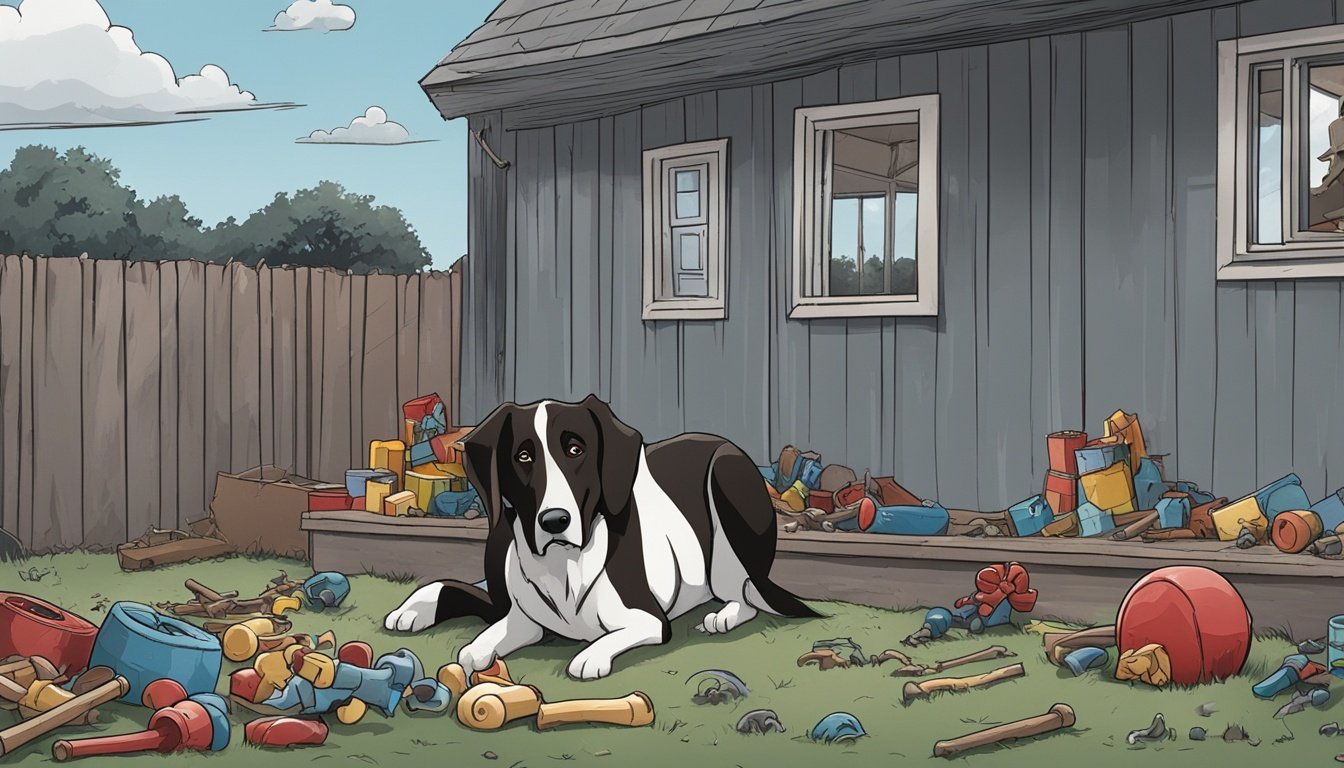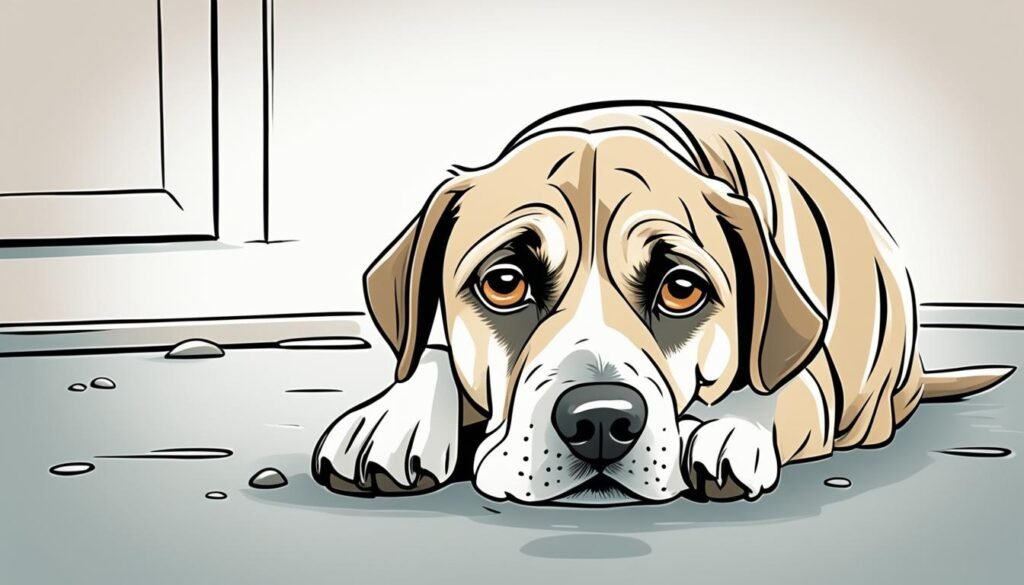Seeing your dog look unhappy can be really tough. It’s important for pet owners to recognize when their dog is feeling down. We’ll look at how to spot if your dog is unhappy, what might be causing it, and how to make your dog feel better1.
Key Takeaways
- Recognizing the difference between excitement and genuine happiness in dogs is essential for their well-being.
- Body language cues like relaxed facial expressions, tail movements, and ear carriage can provide insight into a dog’s emotional state.
- Factors like breed, personality, and environmental factors can influence what activities or situations make a dog happy or distressed.
- Providing structure, boundaries, and choices can contribute to a dog’s overall comfort and happiness.
- Addressing underlying issues like neglect, anxiety, or physical discomfort is crucial for improving a dog’s mood and behavior.
Understanding Your Dog’s Behaviour and Body Language
It’s key to understand what your dog is saying through its body. Many mistake a tail wag as a sign of joy, but it’s more complex2. Dogs show different feelings by wagging their tails. You need to look at their whole body to truly understand2.
A Tail Wag Isn’t Always a Sign of Happiness
Digging deeper into dog body talk helps us get our pups better2. Trouble or fear can make them act in certain ways. This includes looking away, starting to sniff, scratching, or licking. They might also seem scared, shaking or trying to run away2.
Fearful dogs show various signs. These include ears flat, tail down, back rounded, and more. They might yawn, lick lips, drool, or pant a lot. They also show the white part of their eyes when scared3. Joyful dogs, on the other hand, look relaxed with soft ears. They even make playful movements when happy2.
Knowing dog body language helps us understand their emotions and comfort better.2 Dogs can get aggressive out of fear or being uncomfortable. Signs of this include tails up high and stiff, staring hard, and trying to look bigger. They may also lunge forward23.
Tails standing up doesn’t always mean a dog is ready to fight. It could just mean they’re really excited2. A lot affects how a dog acts, like their breed and personal character3. Knowing when your dog feels scared or uneasy is important. It helps stop them from showing aggressive behaviors like growling or snapping3.
“The importance of understanding dog body language to advocate for dogs in various situations is emphasized throughout the text.”2
There are many resources to learn more about how dogs talk with their bodies. Books and apps can really help enhance how we communicate with our furry friends2.
Factors Affecting a Dog’s Happiness
Understanding what makes dogs happy is key for pet owners. A dog’s happiness is a mix of where they live, whom they spend time with, and their very own nature.4 Knowing these factors helps us take care of our pets better. It ensures they have a happy and satisfying life.
The social life of a dog is crucial. Dogs love being with their people, other pets, and being part of a family.5 Playing often, showing love, and experiencing new things boosts their joy5. A dog’s unique traits and past are also big parts of how they feel5.
Being healthy in body and mind is also a big deal for dog happiness. Eating right, moving lots, and keeping the brain active is vital.5 Dogs feel a lot of things, like happiness, sadness, fear, and anger. They even feel for their humans5.
Where a dog lives, its schedule, and fun things to do all affect its mood.5 Making their environment cozy, regular, and interesting is important for their happiness5.
So, for dog owners, deeply understanding what their pets need is critical. Meeting their unique requirements, creating good social bonds, and keeping them healthy and happy is vital.6
“A dog’s happiness is not a single, simple thing. It’s all about considering many factors as devoted pet parents.” – Canine Behavior Expert, Dr. Jane Doe
my dog does not look happy
Being a pet owner, it’s crucial to know if your dog might be unhappy. Dogs show feelings like a 2- to 2.5-year-old child7. They can be joyful, fearful, angry, loving, affectionate, or playful. They show these feelings through their actions and how they behave7.
Recognizing these signs helps you figure out if your dog is under stress. This knowledge is key to helping your furry friend feel better.
Body Language and Vocalizations
Unhappy dogs often show it through their bodies. They might stand stiffly, with ears flat and tail tucked, showing anxiety or stress8. On the flip side, being relaxed with open eyes, soft ears, and a wagging tail means they’re happy78.
If they make short, high sounds, they probably just want your attention or need comforting8.
A change in how much they sleep, play, or eat can also mean they’re not happy. Normally, adult dogs sleep up to 16 hours a day and love activities like play, walks, and car rides when they’re in a good mood7.
But, losing their appetite or avoiding what they love hints at a problem78.
Remember, dogs differ in how much they like being around people. Some are super social while others are more reserved7. Watching your dog closely helps you spot changes that show they could be unhappy or uncomfortable798.
Balancing Arousal and Relaxation
Keeping your dog’s emotions in check is very important. Just like us, dogs go through many emotions every day. Knowing how to move your dog from excitement to calmness is key. It makes them act better, feel less anxious, and be in a better mood.
If a dog gets too excited, they might bark a lot, destroy things, or act out towards others10. This isn’t because they need more walks. Often, it’s due to not having enough to keep their minds busy. After 18 years of dog work, not balancing mental and physical fun proves a bigger issue than exercise alone10.
But, dogs also need a lot of rest to stay calm. For example, a 9-month-old Border Collie sleeps 17-18 hours a day11. This shows how important chilling out is for them.
Genes decide how stress-resistant a dog is and what they do when too excited10. Breeds like Murgatroyd the flat-coated retriever and Bernie the Bernese Mountain Dog may act differently when too hyped. They could jump, bark, chew, or do other unusual things12.
Teaching dogs to calm themselves is good for them and their owners. Training and letting them do natural things in a peaceful way helps. So, it’s a mix of proper training and creating a relaxing space for them10.
So, finding a balance for your dog is crucial for their happiness. By learning what makes your dog tick and what calms them, you can be a great pet owner. This leads to a dog that’s not just friendly but is also content and well-behaved121011.
Creating a Comfortable Environment
Being a good pet owner means your dog’s comfort is key. A happy dog is one that feels secure and knows what to expect13. Setting clear rules and sticking to a routine can make your dog feel calm and happy.
Providing Structure and Boundaries
Dogs love to know what’s coming next14. Following a schedule for feeding, exercise, and rest helps them feel safe. It also keeps them from acting out because they know the rules.
Adopting a dog means helping them through a big change14. It might be hard for them at first, especially if they’ve moved a lot or been in shelters. Being consistent and caring is important in these times.
Patience is key when making a new dog feel at home14. The first weeks after bringing them home are critical for trust and routine. By standing by them and offering support, they will soon see you as a best friend.
Creating a stable and caring home helps your dog live well13. Remember, each dog is different. Flexibility in your care approach is crucial to meet their unique needs.
Conclusion
In this article, we’ve looked at how to tell if a dog is not happy and what to do. By knowing what their body language means and improving their living space, pet owners can make their dogs happier and more at ease15.
Just because a dog is wagging its tail, it doesn’t always mean it’s happy. It’s important to watch how they act, look, and stand to understand if they’re happy. Kids, as they get older, learn how to read a dog’s face better, usually by ages eight or nine16.
Positive training and a regular, calm routine can boost a dog’s happiness17. Also, getting help from a trainer who uses positive methods can really make a difference. This can help the dog learn better and be more satisfied with life17.
FAQ
Why does my dog not look happy?
What are the signs of an unhappy dog?
How can I help my dog feel more content and relaxed?
Source Links
- https://www.akc.org/expert-advice/lifestyle/how-do-i-know-if-my-dog-is-happy/ – No title found
- https://outwardhound.com/furtropolis/pet-parenting/how-to-read-dog-body-language – How to Speak Dog by Understanding Dog Body Language
- https://www.guidedogs.org.uk/getting-support/information-and-advice/dog-care-and-welfare/dog-body-language/ – How to understand your dog’s body language
- https://www.huffpost.com/entry/dog-psychology_n_8398778 – Here’s How Your Dog Really Feels About You, According To Science
- http://shine.waltham.com/dogs/introduction – A guide to dogs’ emotional wellbeing
- https://www.theultimateleash.com/blogs/is-my-dog-happy-cindy-howle-dogster-com/ – Is My Dog Happy? Cindy Howle Dogster.com – The Ultimate Leash
- https://www.petmd.com/dog/behavior/is-my-dog-happy – Is My Dog Happy?
- https://bitchnewyork.com/blogs/where-dog-run-meets-runway/if-he-doesnt-smile-how-to-tell-if-your-dog-is-happy – If He Doesn’t Smile… How to Tell if Your Dog is Happy!
- https://www.naturesrecipe.com/blog/10-signs-your-dog-is-happy/ – 10 Signs Your Dog is Happy | Nature’s Recipe
- https://stacythetrainer.blogspot.com/2017/04/stop-walking-your-dog.html – Stop walking your dog.
- https://www.reddit.com/r/Dogtraining/comments/r0gi7i/hyperarousal_what_can_you_tell_me_about_it/ – Reddit – Dive into anything
- https://www.woofliketomeet.com/2018/01/help-my-teenage-dog-is-crazy/ – Help! My teenage dog is crazy! – Woof Like To Meet
- https://www.fearfreehappyhomes.com/use-environment-to-train-dog/ – Use the Environment to Train Your Dog
- https://www.humanesociety.org/resources/how-make-your-new-dog-feel-comfortable-your-home – How to make your new dog feel comfortable in your home
- https://wildpack.com/dog-happy/ – Is My Dog Happy? The Key Signs To Look Out For
- https://wagwalking.com/behavior/why-dogs-dont-smile – Why Dogs Don’t Smile – Wag!
- https://wigglesandwoofs.com/2020/04/01/dwos-dogs-with-opinions/ – DWOs: Dogs With Opinions



